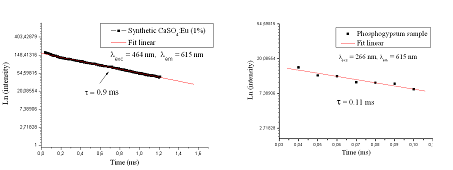
Rare Earth Luminescence in Phosphogypsum Waste Produced From Phosphate Ore Processing
Abstract
Luminescence properties of rare earth elements (Eu3+, Sm3+ and Ce3+) were investigated in phosphogypsum waste produced from the phosphoric acid manufacture. The presence of these elements was already confirmed after analysis of the phosphogypsum sample by inductively coupled plasma mass spectrometry, which showed total rare earths content about 350 ppm. The principal aim of this work is to use the photoluminescence technique for identifying 4f ions by the mutual relationship between excitation and emission spectra. The obtained spectra may be used then as reliable references for monitoring rare earth elements during their extraction from phosphogypsum, any time that the inductively coupled plasma mass spectrometry is inapplicable.
To find the most convenient conditions for observing Eu3+ emissions, a powder of calcium sulfate doped with europium (CaSO4: Eu (1%)) was synthesized. After comparison with the emission and excitation spectra of the synthetic gypsum, it was pointed out that excitation of the phosphogypsum selectively at 466 nm is the most suitable for observing Eu3+ emissions. These latter were obtained at around 556 nm and 603 nm. Based on literature data, Sm3+ and Ce3+ emissions in the phosphogypsum were identified. Sm3+ lines were obtained at 567 nm and 602 nm after a selective excitation at the 4G5/2-6H7/2 transition (404 nm). Whereas cerium luminescence was only observed after calcination of the phosphogypsum sample at 900°C. Ce3+ emissions were obtained at around 305 nm and 326 nm after excitation of the calcined phosphogypsum at 254 nm. The effect of phosphogypsum impurities on the lifetime of rare earths emissions was also discussed.
Full Text:
PDFReferences
S.A. Mohitkar, G. Kalpana, K. Vidyasagar, Journal of Solid State Chemistry, 2011, 184, 735–740.
M. Gaft, R. Reisfeld, G. Panczer, Ph. Blank, G. Boulon, Spectrochimica Acta. Part A, 1998, 54, 2163–2175.
Refbacks
- There are currently no refbacks.
Copyright (c) 2015
